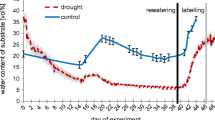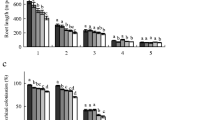Abstract
Interactive effects of elevated atmospheric CO2 and phosphorus supply on mycorrhizal colonization rates were investigated using loblolly pine (Pinus taeda L.) seedlings from Florida and coastal North Carolina. Seedlings from both populations were grown in greenhouses maintained at either 35.5 Pa or 71.0 Pa CO2. In both CO2 treatments, seedlings were grown in a full factorial experiment with or without mycorrhizal inoculum and with an adequate or a limiting supply of phosphorus. Seedlings were harvested 60, 90 and 120 days after emergence and at each harvest root subsamples were examined to determine the percent of fine roots that were mycorrhizal. Additionally, root carbohydrate and nutrient levels were measured at each harvest. Root starch, sugar and total non-structural carbohydrate (TNC) concentrations were increased by growth in elevated CO2 and decreased by mycorrhizal colonization. Phosphorus stress decreased root starch concentrations, increased root sugar concentrations and did not significantly affect TNC concentrations. However, despite significant effects on root carbohydrate levels, there were generally no significant treatment effects on mycorrhizal colonization. Additionally, at all harvests, root starch and sugar concentrations were not correlated with percent of fine roots that were mycorrhizal. These results suggest that although elevated CO2 may significantly increase root carbohydrate levels, the increases may not affect the percent of fine roots that are mycorrhizal.
Similar content being viewed by others
Abbreviations
- M:
-
mycorrhizal
- NM:
-
non-mycorrhizal
- TNC:
-
total non-structural carbohydrates
References
Borges R G and Chaney W R 1989 Root temperature affects mycorrhizal efficacy in Fraxinus pennsylvanica Marsh. New Phytol. 112, 411–417.
Conroy J P, Milham P J, Reed M L and Barlow E W 1990 Increases in phosphorus requirements for CO2-enriched pine species. Plant Physiol. 92, 977–982.
Dickson R E 1979 Analytical procedures for the sequential extraction of 14C labelled constituents from leaves, bark and wood of cottonwood plants. Physiol. Plant. 45, 480–488.
Douds D DJr. and Schenck N C 1990 Relationship of colonization and sporulation by VA mycorrhizal fungi to plant nutrient and carbohydrate contents. New Phytol. 116, 621–627.
Dubois M, Gilles K A, Hamilton J K, Rebers P A and Smith F 1956 Colorimetric method for determination of sugars and related substances. Anal. Chem. 28, 350–356.
Hacskaylo E 1973 Carbohydrate physiology of ectomycorrhizae. In Ectomycorrhizae. Eds. G CMarks and T TKozlowski. pp 207–231. Academic Press, New York.
Hatch A B 1937 The physical basis of mycotrophy in Pinus. Black Rock For. Bull. 6, 1–168.
Jones M D, Durall D M and Tinker P B 1990 Phosphorus relationships and production of extramatrical hyphae by two types of willow ectomycorrhizas at different soil phosphorus levels. New Phytol. 115, 259–267.
Koide R T 1991 Nutrient supply, nutrient demand and plant response to mycorrhizal infection. New Phytol. 117, 365–386.
Lincoln D E, Couvet D and Sionit N 1986 Response of an insect herbivore to host plants grown in carbon dioxide enriched atmospheres. Oecologia 69, 556–560.
Marx D H 1990 Soil pH and nitrogen influence Pisolithus ectomycorrhizal development and growth of loblolly pine seedlings. For. Sci. 36, 224–245.
Marx D H, Hatch A B and Mendicino J F 1977 High soil fertility decreases sucrose content and susceptibility of loblolly pine roots to ectomycorrhizal infection by Pisolithus tinctorius. Can. J. Bot. 55, 1569–1574.
Norby R J, O'Neill E G and Luxmoore R J 1986 Effects of atmospheric CO2 enrichment on the growth and mineral nutrition of Quercus alba seedlings in nutrient-poor soil. Plant Physiol. 82, 83–89.
Norby R J, O'Neill E G, Hood W G and Luxmoore R J 1987 Carbon allocation, root exudation and mycorrhizal colonization of Pinus echinata seedlings grown under CO2 enrichment. Tree Physiol. 3, 203–210.
O'Neill E G, Luxmoore R J and Norby R J 1987 Increases in mycorrhizal colonization and seedling growth in Pinus echinata and Quercus alba in an enriched CO2 atmosphere. Can. J. For. Res. 17, 878–883.
Same B I, Robson A D and Abbott L K 1983 Phosphorus, soluble carbohydrates and endomycorrhizal infection. Soil Biol. Biochem. 15, 593–597.
Strain B R and Cure J 1985 Direct effects of increasing carbon dioxide on vegetation. Publication ER-0238, United States Department of Energy, Washington, DC.
Sutton B G, Ting I P and Sutton R 1981 Carbohydrate metabolism of cactus in a desert environment. Plant Physiol. 68, 784–787.
Thomson J P, Robson A D and Abbott L K 1986 Effects of phosphorus on the formation of mycorrhizas by Gigaspora calospora and Glomus fasciculatum in relation to root carbohydrates. New Phytol. 103, 751–765.
Author information
Authors and Affiliations
Rights and permissions
About this article
Cite this article
Lewis, J.D., Thomas, R.B. & Strain, B.R. Effect of elevated CO2 on mycorrhizal colonization of loblolly pine (Pinus taeda L.) seedlings. Plant Soil 165, 81–88 (1994). https://doi.org/10.1007/BF00009965
Issue Date:
DOI: https://doi.org/10.1007/BF00009965




